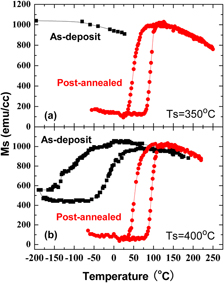Crossref Citations
This article has been cited by the following publications. This list is generated based on data provided by
Crossref.
Suzuki, Ippei
Itoh, Mitsuru
and
Taniyama, Tomoyasu
2014.
Elastically controlled magnetic phase transition in Ga-FeRh/BaTiO3(001) heterostructure.
Applied Physics Letters,
Vol. 104,
Issue. 2,
p.
022401.
Witte, Ralf
Kruk, Robert
Gruner, Markus E.
Brand, Richard A.
Wang, Di
Schlabach, Sabine
Beck, Andre
Provenzano, Virgil
Pentcheva, Rossitza
Wende, Heiko
and
Hahn, Horst
2016.
Tailoring magnetic frustration in strained epitaxial FeRh films.
Physical Review B,
Vol. 93,
Issue. 10,
Merkel, Dániel G.
Lengyel, Attila
Nagy, Dénes L.
Németh, Attila
Horváth, Zsolt E.
Bogdán, Csilla
Gracheva, Maria A.
Hegedűs, Gergő
Sajti, Szilárd
Radnóczi, György Z.
and
Szilágyi, Edit
2020.
Reversible control of magnetism in FeRh thin films.
Scientific Reports,
Vol. 10,
Issue. 1,
Fina, Ignasi
Dix, Nico
Menéndez, Enric
Crespi, Anna
Foerster, Michael
Aballe, Lucia
Sánchez, Florencio
and
Fontcuberta, Josep
2020.
Flexible Antiferromagnetic FeRh Tapes as Memory Elements.
ACS Applied Materials & Interfaces,
Vol. 12,
Issue. 13,
p.
15389.
Zhang, Yujun
Chen, Jiahui
Ikeda, Keisuke
Yamagami, Kohei
Wang, Yue
Choi, Yongseong
Yasui, Akira
Ma, Jing
Lin, Yuanhua
Nan, Cewen
and
Wadati, Hiroki
2022.
Synchrotron X-ray spectroscopic study of the antiferromagnetic-ferromagnetic transition in Ni-doped FeRh epitaxial thin films.
Journal of Alloys and Compounds,
Vol. 921,
Issue. ,
p.
166080.
Zha, Dezhi
Wang, Baomin
Yuan, Lu
Xie, Yali
Yang, Huali
Huang, Kai
Yu, Lan
and
Li, Run-Wei
2022.
Control of metamagnetic phase transition in epitaxial FeRh films by changing atomic order degree.
Journal of Magnetism and Magnetic Materials,
Vol. 557,
Issue. ,
p.
169465.
Kumar, Hardeep
Morelhao, Sergio L.
Pessotto, Gerson
Singh, Hardepinder
Sinha, Anil K.
and
Cornejo, Daniel R.
2022.
Structural and magnetic properties of FeRh films grown on MgO(0 0 1), MgO(0 1 1) and MgO(1 1 1) substrates.
Journal of Magnetism and Magnetic Materials,
Vol. 556,
Issue. ,
p.
169442.
Merkel, Dániel Géza
Hegedűs, Gergő
Gracheva, Maria
Deák, András
Illés, Levente
Németh, Attila
Maccari, Fernando
Radulov, Iliya
Major, Márton
Chumakov, Aleksandr I.
Bessas, Dimitrios
Nagy, Dénes Lajos
Zolnai, Zsolt
Graning, Sára
Sájerman, Klára
Szilágyi, Edit
and
Lengyel, Attila
2022.
A Three-Dimensional Analysis of Magnetic Nanopattern Formation in FeRh Thin Films on MgO Substrates: Implications for Spintronic Devices.
ACS Applied Nano Materials,
Vol. 5,
Issue. 4,
p.
5516.
Harton, Renee M.
Ceballos-Sanchez, Alejandro
Unikandanunni, Vivek
Gray, Alexander X.
Bonetti, Stefano
Krüger, Peter
and
Hellman, Frances
2024.
Characterizing the nonequilibrium response of FeRh thin films using time-domain thermoreflectance.
Physical Review B,
Vol. 110,
Issue. 9,
Seo, Sang-il
Park, Min-Tae
and
Jung, Myung-Hwa
2024.
Impact of Co doping on the magnetic and transport properties of FeRh.
APL Materials,
Vol. 12,
Issue. 12,
Park, Min-Tae
Yang, Jiseok
Ahn, Junil
Seo, Sang-il
Yoo, Woosuk
Lee, Young Haeng
Yoo, Hyobin
Kim, Kab-Jin
and
Jung, Myung-Hwa
2024.
Impact of optimized growth conditions for magnetic phase transition and magnetic domain evolution in epitaxial FeRh thin films.
Applied Surface Science,
Vol. 655,
Issue. ,
p.
159539.
